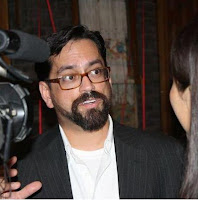
DesignEd Symposium by DIGMA (Design Industry Group of Massachusetts
May 4, 2012: There were some questions proposed to answer. The one that attracted me" How should Massachusetts design education evolve?"
[Photos by Jay Calderin, Boston Fashion Week & SFD.]
Rather than go into all the points about the question, I talked more about the critical problems that the fashion apparel industry was facing today, not only in Massachusetts, but all over the country and all over the world. It is not something that education alone can answer, but has serious consequences for fashion design students, who can no longer find jobs. I made the decision to send the following paper to a group of those who would be especially interested in the critical problems of the fashion apparel industry. It doesn't answer the problem, but identifying the problem is 50% of the solution. I hope my readers will read and think about possible solutions. And I will put some ideas in my next post.
"History Teaches the Present How to Redesign the Future" (Shirley Willett)
__________________________________________________________________________________
Pattern Design and Engineering is the Beginning and the Foundation for Fashion/Apparel as an Industry
The textile industry was
brought to America in the 19th century from England. But the apparel
industry is an American creation later in the Greater Boston area by Jewish
tailors. Prior to their efforts garments were made individually for each woman
by dressmakers. These Jewish tailors became aware of some commonalty in the
shaping, fitting and making of garments, and pattern making for production was born, one pattern to fit more than one woman. They developed
a mathematical sizing system to accommodate most women with very few patterns.
As businessmen they continued developing these patterns to become paper
“information systems” engineered to control quantities of exact reproductions
in cutting and stitching clothing in mass production systems.
It was in the 1950’s,
graduating from college and working in the design rooms of New York, that I
learned something very different about fashion schools and colleges. Teachers were primarily “dressmakers”
and emulated the Paris couture system – and they taught this to other teachers,
becoming a narrowing circle of knowledge and experience. All workers hired in
design rooms were taught in schools, not from apprentice experience that taught
critical production knowledge. I easily excelled way beyond them with a technical
pattern expertise learned from my own experiments as a teenager coupled with
the knowledge of stitching in production. Creators of high fashion styles today
make “First Patterns”, which they spend endless time redoing for quality, but
never preparing for production. While creating high fashion styles my First
Patterns were “Engineered Patterns” to immediately reproduce creations into
ready made garments for cost-effective manufacturing. A positive effect from
these fashion schools is that America began producing more creative designers, but the negative effect is an ever
widening gap between creative design and pattern engineering. In my National
Science Foundation grants,1980s, I designed a graphic that explains it well: “The
Wall Between Design and Manufacturing”. By combining great creativity with unequaled technical expertise, I
became extremely successful as a high fashion designer and manufacturer of
quality designer clothing at low cost, selling nationally to all the top retailers
from the 1960s to the early 1980s. One driving point I continue to make in my
grants and to students is that decisions of marketing and production, costs and
quality must be made at the “Point of Design”. (P.O.D.)
Unfortunately,
as Boston firms went south in the 1960s and then overseas in the 1980s, to
reduce increasingly heavy production costs, Boston's technical expertise faded
dramatically. No longer were there firms to apprentice pattern designers, so
pattern making was only taught in schools from books. Overseas manufacturers,
in Italy, France, London, and today in Japan, China and Korea, copied these
systems as well, but none of them learned it by hands on stitching and other
work in production that makes an expert pattern maker. The result is that today’s
pattern designers and engineers can reproduce the sameness of clothing design,
but cannot create technical pattern design and engineering systems, nor can they ever work
with creative styling to make them into efficient production systems.
Adding to the
demise of creative technical expertise are the CAD/CAM vendors selling
technology into the apparel industry production systems, which had to emphasize
“sameness” to justify the costs. Those elements that are mathematically oriented, such as
“grading of sizes”, and “marking of layouts” for cutting, are very efficient
technological systems. But no CAD vendor has designed a pattern making
system that can deal with creative styling, or fitting of differences in
women’s bodies. The result is that all over the world we have
an anathema of sameness in the
mass production market, and far out creativity that is enormously high
priced - with a gap that is an
ever-widening schism.
When I sold my
manufacturing business in the 1980s and won the NSF grants, it was for the sole
purpose of using our great history in technical pattern design to create
technologies that could work with and for, creativity. I have been accepted all over the world for my creative technical
expertise, but not by the American fashion industry, nor by their schools. I
reached an apogee in representing the whole American fashion industry at an MIT
workshop on comparing design practices between industries. Now, in the 21st
century, I am determined to do whatever I can to “redesign the fashion industry
in America”, by teaching my “Stylometrics Pattern Design” and developing a system of apprentices to
become Fashion Design Leaders.
Fashion schools
graduate thousands of fashion designers that can’t succeed in fashion
nationwide. Consumers are frustrated and bored with sameness, not finding
creative, quality fashions that will fit them without paying thousands of
dollars. Consumers are becoming involved in designing in various ways. I hope
that my creative methodologies will be adopted, and you will take them for your
personal success and to show others.
The Wall Between Design and Manufacturing
The plate and the text comes from a Willett paper, “Syntax and Semantics of an Image Communication Language for Design Management’ presented at the Technical Design Conference of the American Society of Mechanical Engineers in 1990.
For communication tools to be useful in design management, they must be based on a language that supports standardization of representation, linkage of production requirements to product representation, use of building blocks to avoid repetitive effort, and incorporation of syntactical information to aid in understanding of the represented product. The Stylometrics language was designed with these goals and purpose in mind.
CAD technology has exacerbated the problem by developing programs for apparel design that have little regard for the users. Perhaps the primary cause of this wrong direction is the total lack of understanding and respect for what design engineering is, and what the design engineer does.












